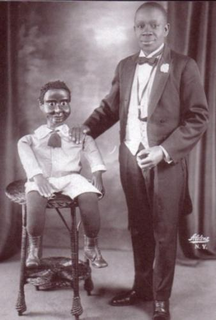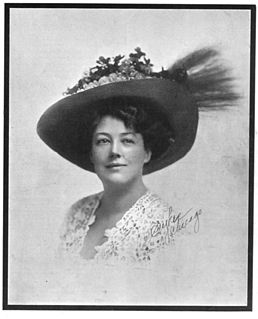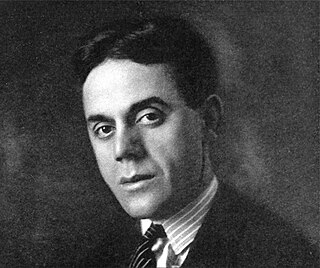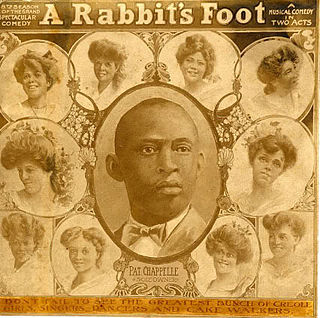
Vaudeville is a theatrical genre of variety entertainment born in France at the end of the 19th century. A vaudeville was originally a comedy without psychological or moral intentions, based on a comical situation: a dramatic composition or light poetry, interspersed with songs or ballets. It became popular in the United States and Canada from the early 1880s until the early 1930s, but the idea of vaudeville's theatre changed radically from its French antecedent.

Stand-up comedy is a comedic style in which a comedian performs in front of a live audience, speaking directly to them through a microphone. The performer is commonly known as a comic, stand-up comic, comedian, comedienne, stand-up comedian, or simply a stand-up. Comedians give the illusion that they are dialoguing, but in actuality, they are monologuing a grouping of humorous stories, jokes and one-liners, typically called a shtick, routine, act, or set. Some stand-up comedians use props, music or magic tricks to enhance their acts. Stand-up comedians perform quasi-autobiographical and fictionalized extensions of their offstage selves.

Bert Williams was a Bahamian-born American entertainer, one of the pre-eminent entertainers of the Vaudeville era and one of the most popular comedians for all audiences of his time. He is credited as being the first black man to have the leading role in a film: Darktown Jubilee in 1914.

Sophie Tucker was a Ukrainian-born American singer, comedian, actress, and radio personality. Known for her powerful delivery of comical and risqué songs, she was one of the most popular entertainers in America during the first half of the 20th century. She was widely known by the superlative nickname "The Last of the Red Hot Mamas".

Antonio Pastor was an American impresario, variety performer and theatre owner who became one of the founding forces behind American vaudeville in the mid- to late-nineteenth century. He was sometimes referred to as the "Dean of Vaudeville." The strongest elements of his entertainments were an almost jingoistic brand of United States patriotism and a strong commitment to attracting a "mixed-gender" audience, the latter being something revolutionary in the male-oriented variety halls of the mid-century. Although he was a performer and producer, Pastor is best known for "cleaning up" bawdy variety acts and presenting a clean and family friendly genre called vaudeville.

Eva Tanguay was a Canadian singer and entertainer who billed herself as "the girl who made vaudeville famous". She was known as "The Queen of Vaudeville" during the height of her popularity from the early 1900s until the early 1920s. Tanguay also appeared in films, and was the first performer to achieve national mass-media celebrity, with publicists and newspapers covering her tours from coast-to-coast, out-earning the likes of contemporaries Enrico Caruso and Harry Houdini at one time, and being described by Edward Bernays, "the father of public relations", as "our first symbol of emergence from the Victorian age."

Bill "Bojangles" Robinson was an American tap dancer, actor, and singer, the best known and the most highly paid black American entertainer in America during the first half of the 20th century. His long career mirrored changes in American entertainment tastes and technology. His career began in the age of minstrel shows and moved to vaudeville, Broadway theatre, the recording industry, Hollywood films, radio, and television.
Theatre Owners Booking Association, or T.O.B.A., was the vaudeville circuit for African American performers in the 1920s. The theaters mostly had white owners and booked jazz and blues musicians and singers, comedians, and other performers, including the classically trained, such as operatic soprano Sissieretta Jones, known as "The Black Patti", for black audiences.

Edward Franklin Albee II was an American vaudeville impresario.

John Walcott Cooper, Jr. was an American ventriloquist, entertainer, and singer with the Southern Jubilee Singers. He was known as the "Black Napoleon of Ventriloquism" and also performed under the pseudonym Hezekiah Jones. Over the course of his lifetime Cooper was a member of the Negro Actors Guild of America, the Colored Vaudeville Benevolent Association, and the International Brotherhood of Ventriloquists.

Blanche Ring was an American singer and actress in Broadway theatre productions, musicals, and Hollywood motion pictures. She was best known for her rendition of "In the Good Old Summer Time."

George Walker was an American vaudevillian, actor, and producer. In 1893, in San Francisco, Walker at the age of 20 met Bert Williams, who was a year younger. The two young men became performing partners. Walker and Williams appeared in The Gold Bug (1895), Clorindy (1898), The Policy Player (1899), Sons of Ham (1900), In Dahomey (1903), Abyssinia (1906), and Bandanna Land (1907). Walker married dancer Ada Overton, who later also was a choreographer.

Jimmy Savo was an American Vaudeville, Broadway, nightclub, film and television performer, comedian, juggler, and mime artist.

The White Rats was a fraternal organization formed by vaudeville performers, led by George Fuller Golden, as a labor union to support the rights of male performers. Women and African-American performers were not allowed to join. The White Rats attempted to combat the monopolistic practices of the United Booking Office (UBO) and the Vaudeville Managers Association (VMA), groups formed by vaudeville theater managers to keep performers' wages low and control when and where performers were allowed to work. It was based on the Grand Order of Water Rats, a British entertainment industry fraternity and charity. It received a charter from the American Federation of Labor in 1910. The union staged several strikes but ultimately disbanded.

George Fuller Golden, was a popular vaudeville entertainer at the beginning of the 20th century. He is best known for his monologues about his fictional friend Casey. He was also a prizefighter. He was the founder of the White Rats, a labor union for vaudeville performers.

Black Vaudeville was based on performances that came out of the movement and style of African Americans. The vaudeville years were the early 1880s until the early 1930s. These acts were unique on the vaudeville scene because the performers brought in different experience that the white performers could not convey. Although African-American performers were mistreated, a Vaudeville gig was better than being a maid or farm worker. Vaudeville had what they called circuits to keep the show business at the time organized. It was difficult for a black performer to be accepted into the white circuit due to the racial issues of the time. Eventually, black circuits were created to give black performers more opportunities. Black Vaudeville made it possible for African Americans to enjoy entertainment through their own heritage.
The Vaudeville Managers Association (VMA) was a cartel of managers of American vaudeville theaters established in 1900, dominated by the Boston-based Keith-Albee chain. Soon afterwards the Western Vaudeville Managers Association (WVMA) was formed as a cartel of theater owners in Chicago and the west, dominated by the Orpheum Circuit. Although rivals, the two organizations collaborated in booking acts and dealing with the performers' union, the White Rats. By 1913 Edward Franklin Albee II had effective control over both the VMA and WVMA. In the 1920s vaudeville went into decline, unable to compete with film. In 1927 the Keith-Albee and Orpheum chains merged. The next year they became part of the RKO Pictures.
William Hammerstein was an American theater manager. He ran the Victoria Theatre on what became Times Square, Manhattan, presenting very popular vaudeville shows with a wide variety of acts. He was known for "freak acts", where celebrities or people notorious for scandals appeared on stage. Hammerstein's Victoria Theatre became the most successful in New York.

H. Franklin "Baby" Seals was an American vaudeville performer, songwriter and pianist, whose successful 1912 song "Baby Seals' Blues" was one of the first published blues compositions, predating W. C. Handy's "The Memphis Blues" by several months.

Edna Howland was an American vaudeville artist. She was best known for her piano playing and soprano voice. Between 1910 and 1920, she toured with Jack Kammerer, an acrobatic comedian. Billed as Kammerer & Howland, the duo described themselves as a “Classical Comedy Singing and Talking Act,” and as performers of “Jollity and Jingles Mirthfully Mingled.” Howland retired from show business in the early 1920s.
















